Human Orbital Spaceflights
![]()
International Flight No. 199STS-86Atlantis (20)87th Space Shuttle missionUSA |
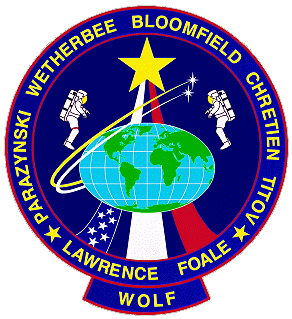 |
 |
 |
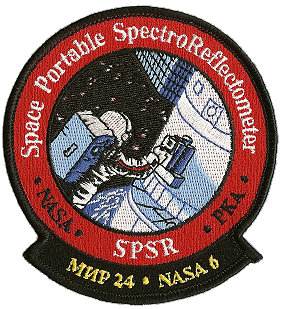 |
|
![]()
Launch, orbit and landing data
walkout photo |
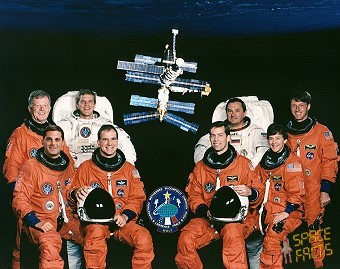 |
|||||||||||||||||||||||||||||||||
alternative crew photo |
alternative crew photo |
|||||||||||||||||||||||||||||||||
alternative crew photo |
||||||||||||||||||||||||||||||||||
alternative crew photo |
||||||||||||||||||||||||||||||||||
Crew
| No. | Surname | Given names | Position | Flight No. | Duration | Orbits | |
| 1 | Wetherbee | James Donald "Wexbee" | CDR | 4 | 10d 19h 20m 50s | 169 | |
| 2 | Bloomfield | Michael John "Bloomer" | PLT, IV-1 | 1 | 10d 19h 20m 50s | 169 | |
| 3 | Titov | Vladimir Georgiyevich | MS-1, PLC, EV-2 | 4 | 10d 19h 20m 50s | 169 | |
| 4 | Parazynski | Scott Edward | MS-2, EV-1, FE | 2 | 10d 19h 20m 50s | 169 | |
| 5 | Chrétien | Jean-Loup Jacques Marie | MS-3 | 3 | 10d 19h 20m 50s | 169 | |
| 6 | Lawrence | Wendy Barrien | MS-4 | 2 | 10d 19h 20m 50s | 169 | |
| 7 | Wolf | David Alexander "Bluto" | MS-5 | 2 | 127d 20h 00m 50s | 2022 |
Crew seating arrangement
|
 |
|
||||||||||||||||||||||||||||||||
Backup Crew
|
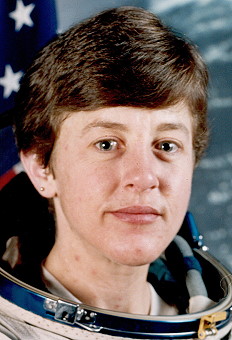 |
|||||||||||
Hardware
| Orbiter : | OV-104 (20.) |
| SSME (1 / 2 / 3): | 2012 (20.) / 2040-1 (3.) / 2019 (18.) |
| SRB: | BI-090 / RSRM 61 |
| ET: | ET-88 (LWT-81) |
| OMS Pod: | Left Pod 03 (24.) / Right Pod 04 (20.) |
| FWD RCS Pod: | FRC 4 (20.) |
| RMS: | - |
| EMU: | EMU No. 3014 (PLSS No. 1014) / EMU No. 3008 (PLSS No. 1008) |
Flight
|
Launch from Cape Canaveral (KSC) and
landing on Cape Canaveral (KSC), Runway 15. This was the seventh of nine planned missions to Mir and the fourth one involving an exchange of U.S. astronauts. Astronaut Michael Foale, who has been on Mir since mid-May 1997, was replaced by astronaut David Wolf. He spent more than four months on the orbiting Russian facility and returned to Earth on Space Shuttle Mission STS-89 in January 1998. Atlantis again carried the SPACEHAB module in the payload bay of the orbiter. The double module configuration housed experiments to be performed by Atlantis' crew along with logistics equipment to be transferred to Mir. The prior Shuttle-Mir missions were STS-71, STS-74, STS-76, STS-79, STS-81 and STS-84. In addition, Scott Parazynski and Vladimir Titov conducted a five-hour spacewalk, or extravehicular activity (EVA), on the fourth day Atlantis is docked with the Mir. It was the first U.S. spacewalk to include participation by a foreign astronaut. The current Mir-24 mission began when cosmonauts Commander Anatoli Soloviyov and Flight Engineer Pavel Vinogradov were launched on August 05, 1997, in Soyuz TM-26 and docked with the Mir two days later. Michael Foale began his stay on the orbiting Russian facility with the Mir-23 crew in mid-May with the docking of STS-84. He became a member of the Mir-24 crew as Research Cosmonaut and continued his science investigations when the Mir-23 crew returned to Earth on August 13, 1997 with the Soyuz TM-25 spaceship. David Wolf was replaced by Andrew Thomas when Endeavour STS-89 docked with Mir in January 1998. Michael Foale's stay was marred by a collision June 25, 1997 between a Progress resupply vehicle and the station's Spektr module, damaging a radiator and one of four solar arrays on Spektr. The mishap occurred while Mir-23 Commander Vasili Tsibliyev was guiding the Progress capsule to a manual docking and depressurized the station. The crew sealed the hatch to the leaking Spektr module, leaving inside Michael Foale's personal effects and several NASA science experiments, and repressurized the remaining modules. An internal spacewalk by Vasili Tsibliyev and Mir-23 Flight Engineer Aleksandr Lazutkin was planned to reconnect power cables to the three undamaged solar arrays, but during a routine medical exam July 13, 1997 Vasili Tsibliyev was found to have an irregular heartbeat. Michael Foale then began training for the spacewalk, but during one of the training exercises a power cable was inadvertently disconnected, leaving the station without power. On July 21, 1997, it was announced that the internal spacewalk would not be conducted by the Mir-23 crew but their successors on Mir-24. On July 30, 1997, NASA announced that Wendy Lawrence, originally assigned to succeed Michael Foale on Mir, was being replaced by David Wolf. The change was deemed necessary to allow David Wolf to act as a backup crew member for the spacewalks planned over the next several months to repair Spektr. Unlike David Wolf, Wendy Lawrence could not fit in the Orlan suit that is used for Russian spacewalks and she did not undergo spacewalk training. Following their arrival at the station August 07, 1997, Mir-24 Commander Anatoli Soloviyov and Flight Engineer Pavel Vinogradov conducted the internal spacewalk inside the depressurized Spektr module August 22, 1997, reconnecting 11 power cables from the Spektr's solar arrays to a new custom-made hatch for the Spektr. During the spacewalk, Michael Foale remained inside the Soyuz capsule attached to Mir, in constant communication with the cosmonauts as well as ground controllers. On September 05, 1997, Michael Foale and Anatoli Soloviyov conducted a six-hour external extravehicular activity to survey damage outside Spektr and to try to pinpoint where the breach of the module's hull occurred. Two undamaged arrays were manually repositioned to better gather solar energy, and a radiation device left previously by Jerry Linenger was retrieved. About two hours before the scheduled docking time on Flight Day Three of the mission, Atlantis reached a point about eight nautical miles (14.8 km) behind the Mir space station and conducted a Terminal Phase Initiation (TI) burn, beginning the final phase of the rendezvous. Atlantis closed the final eight nautical miles (14.8 km) to Mir during the next orbit. As Atlantis approaches, the shuttle's rendezvous radar system began tracking Mir and providing range and closing rate information to Atlantis. Atlantis' crew also began air-to-air communications with the Mir crew using a VHF radio. As Atlantis reached close proximity to Mir, the Trajectory Control Sensor, a laser ranging device mounted in the payload bay, supplemented the shuttle's onboard navigation information by supplying additional data on the range and closing rate. As Atlantis closed in on the Mir, the shuttle had the opportunity for four small successive engine firings to fine-tune its approach using its onboard navigation information. Identical to prior Mir dockings, Atlantis aimed for a point directly below Mir, along the Earth radius vector (R-Bar), an imaginary line drawn between the Mir center of gravity and the center of Earth. Approaching along the R-Bar, from directly underneath the Mir, allows natural forces to assist in braking Atlantis' approach. During this approach, the crew began using a handheld laser ranging device to supplement distance and closing rate measurements made by other shuttle navigational equipment. The manual phase of the rendezvous began just as Atlantis reached a point about a half-mile (900 meters) below Mir. Commander James Wetherbee flew the shuttle using the aft flight deck controls as Atlantis began moving up toward Mir. Because of the approach from underneath Mir, James Wetherbee had to perform very few braking firings. However, if such firings were required, the Shuttle's jets were used in a mode called "Low-Z", a technique that uses slightly offset jets on Atlantis' nose and tail to slow the spacecraft rather than firing jets pointed directly at Mir. This technique avoids contamination of the space station and its solar arrays by exhaust from the shuttle steering jets. Using the centerline camera fixed in the center of Atlantis' docking mechanism, James Wetherbee centered Atlantis' docking mechanism with the Docking Module mechanism on Mir, continually refining this alignment as he approached within 300 feet (91.4 meters) of the station. At a distance of about 30 feet (9.14 meters) from docking, James Wetherbee stopped Atlantis and held stationkeep momentarily to adjust the docking mechanism alignment, if necessary. At that time, a final go or no-go decision to proceed with the docking was made by flight control teams in both Houston and Moscow. When Atlantis proceeded with docking, the shuttle crew used ship-to-ship communications with Mir to inform the Mir crew of the Shuttle's status and to keep them informed of major events, including confirmation of contact, capture and the conclusion of damping. Damping, the halt of any relative motion between the two spacecraft after docking, was performed by shock absorber-type springs within the docking device. Mission Specialist Scott Parazynski had to oversee the operation of the Orbiter Docking System from onboard Atlantis. The docking of Atlantis and Mir took place on September 27, 1997 at 19:58 UTC, with the two mission commanders opening the spacecraft hatches at 21:45 UTC David Wolf officially joined the Mir-24 at noon UTC, September 28, 1997. At the same time, Michael Foale became a member of the STS-86 crew and began moving his personal belongings back into Atlantis. During the six days of docked operations, the joint Mir-24 and STS-86 crews transferred more than four tons of material from the SPACEHAB Double Module to Mir, including approximately 771 kilograms (1,700 lb) of water, experiment hardware for International Space Station Risk Mitigation experiments to monitor the Mir for crew health and safety, a gyrodyne, batteries, three air pressurization units with breathing air, an attitude control computer and many other logistics items. The new motion control computer replaced one that had experienced problems in recent months. The crew also moved experiment samples and hardware and an old Elektron oxygen generator to Atlantis for return to Earth. The only EVA in this mission by Scott Parazynski and Vladimir Titov was performed on October 02, 1997 (5h 01m) for testing tools and technologies needed for the ISS and to recover Mir Environmental Effects Payload (MEEP), which were attached during Mission STS-76. Scott Parazynski and Vladimir Titov exited the upward-facing hatch in the tunnel between Atlantis' crew cabin and the Spacehab module and moved up the Docking Module to release the MEEP packages. The retrieved packages were folded and stowed in sidewall carriers in Atlantis' cargo bay, two carriers located in front of the Orbiter Docking System (ODS) and two located aft of the ODS. Within the MEEP packages, investigators were studying the effects of exposure to the space environment on a variety of materials. MEEP has been gathering data on human-made and natural space debris, capturing some debris for later study. It was attached to Mir's Docking Module during a spacewalk by two Shuttle astronauts during the STS-76 mission in March 1996. MEEP consisted of four separate experiments. The Polished Plate Micrometeoroid and Debris experiment was designed to study how often space debris hit the station, the sizes of these debris, the source of the debris, and the damage the debris would do if it hit the station. The Orbital Debris Collector experiment was designed to capture orbital debris and return them to Earth to determine what the debris are made of and their possible origins. The Passive Optical Sample Assembly I and II experiments consisted of various materials that are intended for use on the International Space Station. These materials included paint samples, glass coatings, multi-layer insulation and a variety of metallic samples. In addition to transferring the MEEP back to Atlantis, Scott Parazynski and Vladimir Titov left an item on the exterior of Mir. A solar array cap was planned to place on the damaged Spektr module on a later Russian spacewalk was brought out of the shuttle airlock and tethered to the exterior of the Docking Module. The solar array cap was too large to be transferred through Mir, and should need to seal off the base of the damaged array on Spektr if and when the array is jettisoned by cosmonauts. Later the leak was not discovered and the solar array cap was not used. The spacewalk continued a series of EVA Development Flight Test (EDFT) spacewalks that were conducted on six past Space Shuttle missions. The tests were designed to evaluate equipment and techniques and build experience among astronauts and ground controllers in preparation for assembly of the International Space Station. Past EDFT spacewalks had evaluated equipment ranging from the labeling to be used on the exterior of the station to the nuts and bolts to be used as connectors. In addition to retrieving the MEEP, Scott Parazynski and Vladimir Titov continued an evaluation of the Simplified Aid For EVA Rescue (SAFER), a small jet-backpack designed for use as a type of life jacket during station assembly. Originally evaluated on Shuttle mission STS-64, the SAFER was designed to be worn by astronauts during station spacewalks to allow them to fly back to the station under their own power in the event they become untethered. The SAFER unit to test on STS-86 was the first flight production model. Scott Parazynski and Vladimir Titov were wearing the devices, and, while remaining tethered and in a foot restraint, they evaluated the deployment of the hand controller and the firing of the automatic attitude hold feature. Firing the automatic attitude hold feature while the astronauts are in a foot restraint tested the firing mechanisms in the device, such as the valves and gas thrusters. The astronauts did not perform any free-flight testing of the SAFER as was performed on STS-64. Scott Parazynski and Vladimir Titov also evaluated equipment designed to be compatible for use by spacewalkers on the U.S. and Russian segments of the International Space Station. The evaluations included a Universal Foot Restraint designed to hold the boots of both U.S. and Russian spacesuits; common safety, equipment and body restraint tethers; and a common tool carrier. The Mir-24 mission began when the cosmonaut crew launched on August 05, 1997, in Soyuz TM-26 and docked with the Mir two days later. Michael Foale joined the Mir-23 crew with the May 17, 1997, docking of Atlantis during Mission STS-84. The return of Atlantis on STS-86 concluded some experiments, continued others and commenced still others. Data gained from the mission supplied insight for the planning and development of the International Space Station, Earth-based sciences of human and biological processes and the advancement of commercial technology. The Space Portable Spectroreflectometer (SPSR) was a new tool designed to measure the effects of the space environment on spacecraft materials. This was the first hand-held, battery-powered device of its kind, allowing astronauts to measure actual spacecraft devices, rather than relying on information gathered from samples. During Extravehicular Activity (EVA) operations scheduled later in 1997, cosmonauts and astronauts will use this device to measure how much energy is being absorbed by the thermal control coatings, or radiator surfaces, of the Mir space station. Radiators, which are used to shed excess heat from the spacecraft, play a vital role as part of the station's cooling system. The Interferometer to study Protein Crystal Growth (IPCG) - flying for the first time on STS-86 and the NASA 6 mission - was an instrument designed to yield valuable preliminary data on how protein crystal growth differs in the microgravity environment of space. Researchers also hoped to develop technologies and methods to improve the protein crystal growth process, which may help unlock future answers to the molecular structure of targeted proteins, leading to the development of new, disease-fighting drugs. The IPCG hardware was transported to the Mir on STS-86 and installed in the microgravity glovebox for experiment operations. Once installed, the interferometer, an instrument for measuring wavelengths of light, collected and stored optical information on a growing crystal in the facility, showing growth in form and structure, as well as in change in concentration of the protein solution surrounding the crystal. A total of three experiments were conducted on six fluid systems. The IPCG hardware was removed from the glovebox and returned to stowage at the completion of the experiments and returned on STS-89. The Commercial Protein Crystal Growth (CPCG) payload was comprised of a Commercial Refrigerator/Incubator Module (CRIM) designed as a generic carrier, and the Commercial Vapor Diffusion Apparatus (CVDA) experiment. The primary objective of the CVDA experiment was to produce large, high-quality crystals of selected proteins under controlled conditions in microgravity. Crystals of sufficient size and suitable quality are essential for protein crystallographic analysis of molecular structures via X-ray diffraction and computer modeling. The vapor diffusion method of protein crystal growth is a technique by which protein crystallization is initiated through change in protein/precipitant concentrations. Water vapor is transported from a droplet protein/precipitant solution at a given pH to a reservoir containing a relatively high concentration of precipitating agent. The process is driven by drop-reservoir vapor pressure difference in a closed volume. Typical precipitating agents are ammonium sulfate, sodium chloride, polyethylene glycol, and methyl pentane diol. The Cosmic Radiation Effects and Activation Monitor (CREAM) was used to collect data on cosmic ray energy loss spectra, neutron fluxes and induced radioactivity as a function of geomagnetic coordinates and detector location within the orbiter. Payload hardware consisted of the active cosmic ray monitor, a passive scintillation crystal canister, two neutron spectrometers and 10 passive detector packages. The active monitor was used to obtain real-time spectral data, while the passive monitors obtained data integrated over the mission duration. An additional control passive detector package was used for obtaining background data prior to launch. The Cell Culture Module-A (CCM-A) payload was formerly known as the Space Tissue Loss / National Institutes of Health- Cells Configuration A. The payload objectives were to validate models for muscle, bone and endothelial cell biochemical and functional loss induced by microgravity stress; to evaluate cytoskeleton, metabolism, membrane integrity and protease activity in target cells; and to test tissue loss pharmaceuticals for efficacy. The experiment unit fitted into a single standard middeck locker that has a modified locker door with its panels removed. The unit took in and vented air to the cabin via the front panel. The experiment was powered and functions continuously from pre-launch through post-landing. The Shuttle Ionospheric Modification with Pulsed Local Exhaust (SIMPLEX) payload of opportunity had no flight hardware; orbiter OMS thruster firings were used to create ionospheric disturbances for observation by the SIMPLEX radars. SIMPLEX had three different radar sites used for collecting data: 1) Arecibo, 2) Kwajalein, and 3) Jicamarca. One of the radar sites (Arecibo) also used a low-level laser to observe the effects on the ionosphere resulting from the thruster firing. The objective of the SIMPLEX activity was to determine the source of Very High Frequency (VHF) radar echoes caused by the Orbiter and its OMS engine firings. The principal investigator (PI) used the collected data to examine the effects of orbital kinetic energy on ionospheric irregularities and to understand the processes that take place with the venting of exhaust materials. SIMPLEX sensors collected data during any encounter opportunity when the orbiter support activities meet the criteria defined. Other experiments conducted during the mission were the Radiation Monitoring Experiment-III (RME-III) and the Midcourse Space Experiment. Two NASA educational outreach programs were also conducted, Seeds in Space-II and KidSat. During the flight, James Wetherbee and Michael Bloomfield fired small jet thrusters on Atlantis to provide data for the Mir Structural Dynamics Experiment (MISDE), which measures disturbances to space station components and its solar arrays. Once Atlantis was ready to undock from Mir, the initial separation was performed by springs that gently pushed the shuttle away from the docking module. Both the Mir and Atlantis will be in a mode called "free drift" during the undocking, a mode that has the steering jets of each spacecraft shut off to avoid any inadvertent firings. Once the docking mechanism's springs had pushed Atlantis away to a distance of about two feet (61 centimeters) from Mir, where the docking devices were clear of one another, Atlantis' steering jets were turned back on and fired in the Low-Z mode to begin slowly moving away from Mir. The shuttle continued to back away through a corridor similar to that used during approach with periodic stops to "stationkeep" in order to collect data for the European laser docking sensor. Atlantis continued away from Mir until it reached a distance of 600 feet (182.9 meters) below the Mir. At this point, Atlantis began a re-approach to a distance of 240 feet (73.1 meters) while Mir maneuvered to an orientation that provides adequate viewing of the damaged areas of its Spektr module. After reaching the 240-foot (73.1 meters) range, Atlantis began a flyaround to photograph the damage from the Progress collision. Once the flyaround/photo survey activities are complete, Atlantis performed a separation burn to move to an orbit below and ahead of Mir. During the flyaround, Anatoli Soloviyov opened a pressure regulation valve twice to allow air into the Spektr module to see if STS-86 crew members could detect seepage or debris particles that could indicate the location of the breach in the damaged module's hull. The leak was not found. The mission was extended one day, due of high winds over the KSCs Shuttle Landing Facility. |
EVA data
| Name | Start | End | Duration | Mission | Airlock | Suit | |
| EVA | Parazynski, Scott | 01.10.1997, 17:29 UTC | 01.10.1997, 22:30 UTC | 5h 01m | STS-86 | Atlantis - Mir | EMU No. 3014 |
| EVA | Titov, Vladimir | 01.10.1997, 17:29 UTC | 01.10.1997, 22:30 UTC | 5h 01m | STS-86 | Atlantis - Mir | EMU No. 3008 |
Note
Photos / Graphics
 |
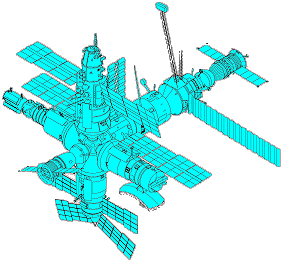 |
 |
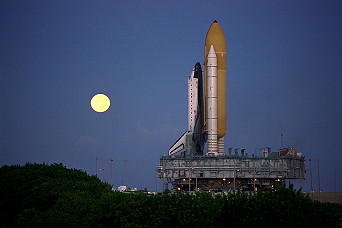 |
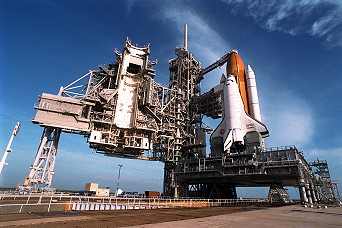 |
 |
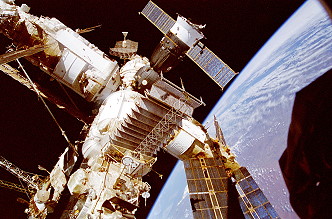 |
 |
 |
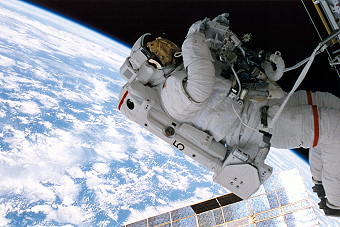 |
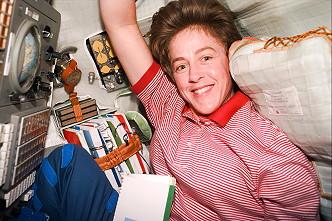 |
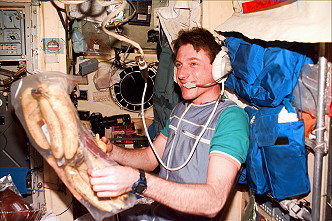 |
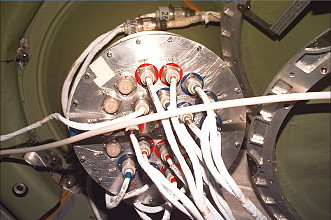 |
 |
 |
 |
more EVA photos |
|
More Mir photos
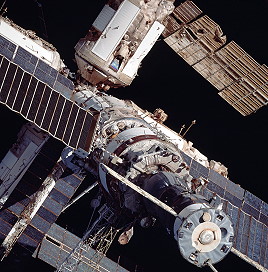 |
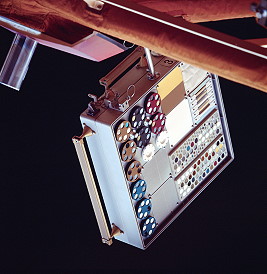 |
 |
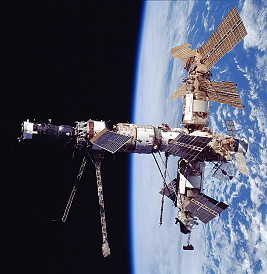 |
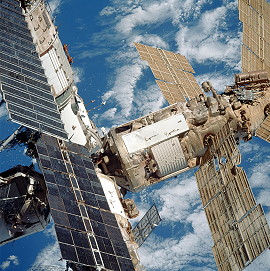 |
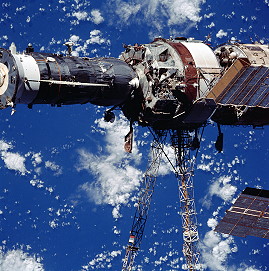 |
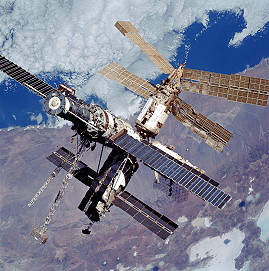 |
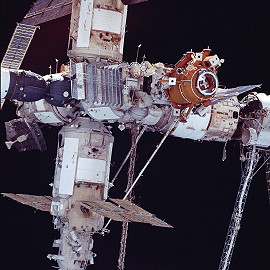 |
| © |  |
Last update on March 28, 2023.  |
 |